| Home
> All About
Bali > Place of Interest |
| |
| Place of Interest |
| |
 |
| |
| |
| |
|
 |
| |
| Bajra Sandhi
Monument |
| Bajra Sandhi Monument is the Balinese
people struggle monument, which is shaped like ‘bajra’
(bell). It is located on Puputan Margarana Square
in Niti Mandala Renon area. Main government offices
are located nearby. |
| |
| Bali
Museum |
Bali museum was built on 8 December
1932 and has a large collection of old items. Located
on Major Wisnu Street, this museum consists of 4
buildings: Buleleng, Karangasem, Tabanan, and the
East Building.
Each building exhibits unique collections. Buleleng
Building exhibits Balinese traditional fabrics and
costumes for religious rituals and ceremonies. Tabanan
Building displays Balinese traditional works of
art, while the East Building exhibits pre-historical
and historical items.
Bali Museum has also become an object of research
work and exhibitions. It is open daily from 08.00
am, except on Saturday and public holidays. |
| |
| Benoa |
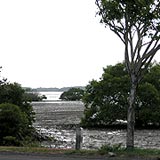 Benoa
is a main harbor as well as the starting point for
numerous cruises around Bali and to Sunda islands.
It is also a center of leisure and sporting activities,
such as parasailing and windsurfing. Benoa
is a main harbor as well as the starting point for
numerous cruises around Bali and to Sunda islands.
It is also a center of leisure and sporting activities,
such as parasailing and windsurfing.
Benoa harbor is about 6km from Denpasar. The International
Yacht Festival is frequently held at this harbor
which involves the participants from around the
world. It starts from Benoa harbor and finishes
at Tanjung Perak harbor in Surabaya. |
| |
| Jaya Sabha
Building |
Located on the north of Puputan
Square, Jaya Sabha Building is the residence of
Governor of Bali Province which was built in Balinese
architecture style.
In front of Jaya Sabha Building is often used as
bullring and the commencement procession of Bali
Art Festival which is held annually in June-July. |
| |
| Jro Kuta
Palace |
| Jro Kuta Palace is located on Kumbakarna
Street, Denpasar, about 100 m of Maospahit Temple.
This palace has unique building complex such as
Ancaksaji, Semanggen, Ranggi, Pewaregan, Saren Raja,
Saren Kangin, Paseban, Pamerajan Agung, and Pekandelan
which is a kind of fortress to protect the main
part of the area. |
| |
| Kesiman
Palace |
| Kesiman Palace is located on W.R.
Supratman Street, East Denpasar, closed to Petilan
Pengerebongan Temple. The palace consists of a private
mansion and the most highly structured family temple. |
| |
| Le Mayeur
Museum |
Located on Hang Tuah Street, Sanur,
this fine art museum exhibits 88 paintings of Belgium
painter, Andrian Jean Le Mayeur de Merpres.
Born on 9 February 1880 in Brussels, Belgium, Le
Mayeur was an architect who preferred to be a painter.
In 1932, he made a trip to Bali and arrived in Buleleng
Harbor. Le Mayeur continued his trip and arrived
in Banjar Kelandis, Denpasar, where he met Ni Nyoman
Pollok, a famous dancer who later became his model.
After a long stay in Banjar Kelandis, Le Mayeur
moved to Sanur and painted with Ni Pollok as model.
They eventually married and built their house on
a 32-hectare of land.
In 1958, Le Mayeur returned to Belgium for cancer
treatment. He passed away on 31 May 1958 and was
buried in Brussels. According to his will, Le Mayeur
bequeathed his house and contents to Ni Pollok.
Following Ni Pollok’s death on 27 July 1985,
this property became a state museum in memory of
Le Mayeur’s works. The museum is open daily
from 08.00 am to 03.00 pm, except on public holidays. |
| |
| Padang
Galak Monument |
| Padang Galak Monument is built to
commemorate the victims of Pan American Airlines
which fallen down in 1972 at Grokgak village, Singaraja,
north Bali. All the passengers died and a number
of victims who could be identified were buried at
this resort of Padang Galak. |
| |
| Pemecutan
Palace |
Pemecutan Palace is located on Thamrin
Street, about 200 m west of Puputan Square. The
palace was built in the 16th century and is well-known
for its unique Balinese traditional architecture
and for its beautiful royal family shrines.
Pemecutan Palace consists of a hotel with traditional
style. There is also a set of traditional musical
instruments (gamelan). |
| |
| Prasasti
Blanjong (Blanjong Inscription) |
Prasasti Blanjong (Blanjong Inscription),
a historical ancient artifact, is now preserved
in Blanjong Temple, Banjar Blanjong, Sanur. The
inscription, which shapes like a stone pillar, was
made by the Buddhist king Sri Kesari Warmadewa in
914 AD.
Discovered in 1932 by Dr. Gorris, a Ducth scholar,
the inscription tells about the military expedition
against eastern Indonesia. Dr. Gorris believed that
the inscription as well as the remains of prehistoric
sanctuaries founded along the coastal line proved
an Indian colony settled the coast over 1,000 years
ago.
The inscription is 177 cm high and its diameter
is 75 cm. Most of the writings are indecipherable,
except at the top.
The inscription was written in two kinds of letters:
the Pre-Negari letters which used Ancient Balinese
language, and the Old Javanese letters which used
Sanskrit language. There were also a number of statues
found in Blanjong area.
One of the statues is Ganesha statue which is placed
in a shrine inside Blanjong temple, about 15 m northwest
of the inscription. Ganesha, the four hands god
with elephant face, is the son of Shiva who gives
prosperity to all humankind. |
| |
| Puputan
Square |
Puputan Square is a large open square
in the center of Denpasar city, the site of the
famous ‘Puputan’ fight to death against
the Dutch troops on 20 September 1906, when thousands
of Balinese warriors, dressed in their finest Balinese
regalia, and armed only with tradition weapons like
keris (short draggers) and spears, hurled themselves
against the lines of Dutch troops.
A monument was built at the northern part of the
Puputan Square to commemorate Puputan battle. The
monument shows a man and his two children carrying
keris (short draggers) and bamboo spears, ready
to fight. |
| |
| Sanur |
| Bali's first beach resort, Sanur
is a place of remarkable contrasts. In this modern
and prosperous community - home to many high class
hotels and restaurants - there is also found considerable
sorcery. Sanur is famous throughout Bali for its
black and white magic. It was also the landing point
for Dutch forces in 1906 on their way to destroy
the royal house of Pemecutan in Denpasar. |
| |
| Satria Palace |
| Satria Palace is located on Veteran
Street, Denpasar, about 300 m north of Puputan Square.
The large and beautiful royal family temple is used
not only by the royal family members but also by
people in the neighborhood.
The buildings inside the palace are unique. There
is also an open hall which was previously used
for meetings of the kings throughout Bali. |
| |
| Sidik
Jari Museum |
Located on Hayam Wuruk Street, Denpasar,
Sidik Jari Museum is a private fine art museum established
and owned by I Gusti Ngurah Gede Pemecutan. The
museum exhibits the work of its owner as well as
other artists.
The uniqueness of the collection in this museum
is that the paintings are done using the tips of
the fingers in applying different colors or paints
in order to represent the artist's imagination.
This museum consists of a hall for exhibitions,
a library, a studio, an open hall for various activities,
and an outdoor stage for dance performances. It
is open daily from 09.00 am to 04.00 pm except on
public holidays. |
| |
| Werdhi Budaya
Art Center |
Werdhi Budaya Art Center is located
on Nusa Indah Street, about 2 km east of Puputan
Square, and covers an area of about 5 hectares.
Werdhi Budaya Art Center consists of various building
complexes. The main building, Mahudara Mandhara
Giri Bhuwaana, was officially opened to the public
on 14 February 1973, and is used for permanent art
exhibitions.
To the north of Mahudara Mandhara Giri Bhuwaana,
there is Gedung Kriya Uccaihsrawa building where
the Balinese and foreign fine arts exhibitions are
held.
To the west of Gedung Kriya Uccaihsrawa, there is
Dewi Ratih building. During Bali Art Festival, this
two-story building is used for architectural exhibition
on the ground floor and photography exhibition on
the second floor.
The largest structure in Werdhi Budaya Art Center
is Ardha Candra Amphitheater which covers 7,200
square meters. This enormous crescent shaped theater
can hold up to 600 people. Ticketing offices and
handicraft exhibition rooms are located underneath
the stage.
To the west of Ardha Candra Amphitheater is the
two-story Ksirarnawa indoor theater which covers
5,850 square meters. The theater, which is located
on the second floor, can hold up to 800 people.
The first floor is occupied by Art Center offices,
a cafeteria, and several halls which are used for
handicraft exhibitions. |
| |
|
 |
| |
| Ayung River
|
| Ayung River is the longest as well
as the largest river in Bali and well-known for
its white water rafting. Besides the enjoyment of
challenging rapids and its beautiful panorama, this
virgin nature area is highlighted by the appearance
of wild animals along the rafting route such as
big bats, black monkeys, magpies and more. |
| |
| Jimbaran |
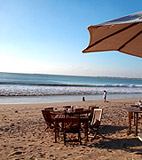 On
the western site of the Bukit (hill),
Bali 's southern Peninsula. lies the once sleepy
fishing village of Jimbaran, now the site of teh
Intercontinental, Four Seasons and the Ritz-Carlton.
Take a walk along the pristine sand or dine at one
of the beachside seafood restaurants. Perhaps a
sunset drink - Jimbaran is known for its spectacular
sunsets. An offshore reef offers protection from
the wave action, providing excellent swimming water. On
the western site of the Bukit (hill),
Bali 's southern Peninsula. lies the once sleepy
fishing village of Jimbaran, now the site of teh
Intercontinental, Four Seasons and the Ritz-Carlton.
Take a walk along the pristine sand or dine at one
of the beachside seafood restaurants. Perhaps a
sunset drink - Jimbaran is known for its spectacular
sunsets. An offshore reef offers protection from
the wave action, providing excellent swimming water.
|
| |
| Kuta |
| Since the 18th
century Kuta has served as the entry for foreigners
visiting southern Bali. In the 1830s Kuta was a
thriving slave market, attracting a wide variety
of international 'lowlifes'.
Since its rediscovery by hippies and surfers in
the 1960s, Kuta and Legian have expanded so rapidly
that the district is now one of the busiest tourist
areas in the world. Hundreds of hotels, bars, restaurants
and shops provide for all tastes and budgets. |
| |
| Legian |
| Legian is on the North of Kuta and
on the South of Seminyak, it is very hard to tell
where it ends. Not too long ago this area was fertile
rice paddy, but now it is a bustling area dotted
with chic designer shops that can hold their own
against any competition. |
| |
| Nusa Dua
|
| The most recent of Bali's tourist
centres, Nusa Dua - located on the Island's southern-most
tip, is quite unlike anything else in Bali. A government-run
dreamland of coconut palms, five-star hotels and
perfect beaches. A great place to relax in the sun
and be pampered, but this is a long way from Balinese
village life. |
| |
| Nungnung
Waterfall |
Nungnung is a small village, about
40km north of Denpasar. It is located 900 m above
sea level and known for its cool refreshing air.
In this village, there is a 50m high waterfall,
called Nungnung Waterfall. To reach this waterfall,
one must pass through the expansive rice terraces,
about 2km off the main road. |
| |
| Petang (Pelaga
Village) |
| Located 800m above sea level, about
32km north of Denpasar, at the northern part of
Badung regency. Both villages portray fascinating
agro tourism areas due to their intact ecology.
Their vast horticulture of vegetable, coffee, vanilla,
corn, and more, adds to the beauty of the sights
and their charming atmosphere. |
| |
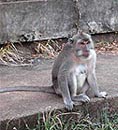 |
| Sangeh |
| Sangeh is the village
whose northern area covers about 14
hectares of a holy homogeneous forest
of Pala trees, inhabited by hundreds
of monkeys. The trees cannot be found
in any other area and their existence
in this village remains a mystery. There
is also a beautiful mossy temple, hidden
amongst the tall and gracious Pala trees.
|
|
|
| |
| Seminyak |
| Little by little Seminyak is coming
into its own as an area to be reckoned with. The
restaurant scene in Seminyak is vibrant and eclectic
while the area's nightclubs have set the pace in
Bali for some time now - this is where you go after
you're done all you can in Kuta. Perhaps for this
reason the area has become a magnet for designers,
both local and international, and many small hotels
and villas have been built in Seminyak reflecting
the cosmopolitan nature of the area Canggu is more
or less an extension of Seminyak, as some folks
- either try to escape the crowds or just came late
to the party and found Seminyak a bit too expensive
- have continued the Kuta sprawl north. |
| |
| Tanah
Wuuk |
Tanah Wuuk is a beautiful river
valley of Tukad Penet, only 1km north of Sangeh
holy monkey forest. Its location is 500m west off
the main road, hidden behind rice field, and is
a very quiet and private place to enjoy the pure
nature.
Its beautiful green valley is very fascinating and
tranquil which makes it a perfect place for relaxing
or hiking through the river valley and Penet River.
|
| |
| Tanjung
Benoa |
| The marshes were never to become
rice fields; the bay remained a bay with lingo cape,
Tanjung Benoa, jutting into it. Nevertheless, Kebo
Iwa, who created the area, is now engaged in a new
venture - luxury hotels and a fast variety of tourist
and water sport attractions. For centuries, the
natural means of communication between this area
and the rest of Bali was by boat from Tanjung Benoa
as this was easier than overland via Jimbaran. Tanjung
Benoa, which appears isolated at the tip of the
peninsula was in fact a trading port for Badung
and the eastern Bukit with a world outlook extending
right across the archipelago. Its population bears
traces of this mercantile past. |
| |
| Traditional
Village of Baha |
Baha Village is located about 4
km east of Taman Ayun Temple. The workers and the
traditional farmers are the major population in
Baha.
The uniqueness of this traditional village is the
uniformity of the entrance gates of the family compounds
combines with the traditional housing structure,
which portrays a fascinating appearance for the
village. |
| |
| Tuban |
| Just south of Kuta lies another
small fishing village community, Tuban. Largely
overshadowed by its more famous neighbour (Kuta),
Tuban has recently emerged as a tourist area in
its own right and is now home to well several known
international chain hotels - among them Ramada and
Holiday Inn and several family oriented amusement
parks. Tuban has a very good mix of hotel accommodations
starting from losmen through 5 Star properties and,
being more relaxed and a bit quieter, has earned
a reputation as a family oriented, value for money
destination. It also very close to the Ngurah Rai
International Airport . |
| |
|
 |
| |
| Kintamani |
Located about 1.500m above sea
level, the beautiful Kintamani area has a cool climate
which is suitable to grow certain fruits and vegetables.
Perched on the rim of a vast crater, overlooking
the Lake Batur and its bubbling hot springs, Kintamani
truly offers stunning scenery.
Kintamani borders on Batur/ Kalanganyar Village.
There is a market up the road to the north, which
is busy every three days on Hari Paseh. It is interesting
to see all kinds of products from surrounding mountain
farms such as oranges, corns, and vegetables.
Kintamani is also well-known for its big furry Kintamani
puppies. Its physical and personality characteristics
make it a popular pet for the Balinese. |
| |
| Penelokan |
Penelokan, which means ‘viewpoint’,
is located in Batur area, about 23km from the town
of Bangli or 63km from Denpasar, exactly on the
southern part of Batur Tengah Village in the district
of Kintamani.
Penelokan tourist resort, located about 900m above
sea level with average temperature of 22°C at
midday and 16°C at night, offers a fabulous
view over the huge crater of Mount Batur and Lake
Batur. Visitors can breathe a cool and fresh mountainous
air, as well as enjoying its magnificent beauty
with its solidarity black lavas of the 1917 eruption
which destroying its surrounding villages.
For visitors who love the adventure can climb up
to the peak. The beauty of its caldera truly beggars
description. Visitors can also take a look at the
beauty of crystal clear water of Lake Batur and
mountainous areas, combined with the unique tradition
of Trunyan Village which cannot be found anywhere
else in Bali. |
| |
| Trunyan
Village |
Trunyan Village is located between
Lake Batur and the outer crater rim of Mount Batur,
and only accessible by boat. It is a Bali Aga village,
inhabited by descendants of the original Balinese,
the people who predate the arrival of Hindu Majapahit
Kingdom in the 16th
century.
Trunyan Village is well-known for its Pancering
Jagat Temple, but visitors are not allowed to enter.
There are also a couple of traditional Bali Aga-style
houses, and a large banyan tree which is said to
be more than 1.100 years old. In Kuban Village,
close to Trunyan Village, there is a mysterious
cemetery, separated by the lake and is only accessible
by boat.
Unlike the Balinese people, Trunyan people do not
cremate or bury the corpse, but just lay the corpse
out in bamboo cages to decompose or under a huge
Taru Menyan (Menyan tree).
Taru means ‘tree’ and Menyan means ‘aromatic
smell’. The word 'Trunyan' is derived from
these two words.
The tree is believed to absorb the bad smells and
instead, produce aromatic smells. Loads of skulls
and bones lie on the stone platform and the surrounding
areas.
The women of Trunyan are forbidden to go to the
cemetery when a corpse is carried there. It is said
that there will be a disaster in the village if
a woman comes to the cemetery while a corpse is
being carried there. |
| |
|
 |
| |
| Air Sanih
(Yeh Saneh) |
Located 17km from Singaraja, Air
Sanih is a serene beach resort where tourists can
plunge in a natural swimming pool. Its icy water
originates from a cool freshwater spring nearby,
located a few meters from the beach. The water is
believed to run from Lake Batur.
Air Sanih beach is also known for its stunning sunrise.
By leaving early enough for Karangasem, tourists
may see the first lights hit the peak of Mount Agung
- a real awesome experience. |
| |
| Menjangan
Island |
Located in the West Bali National
Park, less than an hour by boat from Pemuteran,
Menjangan has the most beautiful coral reefs in
Bali and holds many well-known sites, ranging from
a sheer drop of 60m, small caves, sandy slopes and
a beautiful blue green lagoon. Along with the nearby
Labuan Lalang is a wonderful place for diving and
snorkeling.
During the rainy season is the best time to have
a chance to see whale sharks. Turtle, napoleon,
grouper, big barracuda and shark are all regular
sights. Menjangan also has a wreck known as Anchor,
perched on the top of a reef. The wreck is a 19th
century trading vessel. |
| |
|
 |
| |
| Batubulan |
| Batubulan is well-known for its
stone carvings. Most of the stone sculptures in
Bali are from this area. Batubulan is also famous
for the Barong dance which is performed daily here.
The dance represents the never-ending battle between
good and evil. |
| |
| Celuk and
Singapadu |
| Located near Batubulan, Celuk and
Singapadu are the center of Balinese goldsmiths
and silversmiths. The jewelry is exported worldwide. |
| |
| Goa Gajah |
| Goa Gajah (Elephant
Cave) is located between Pejeng and Gianyar.
It portrays both elements of Hindu and Buddhist.
To enter the cave is through the gigantic mouth
of a demon. There are two pools with spring water
flowing from spouts held by female figure statues
in front of the cave. |
| |
| Pejeng |
Gianyar regency has some of the
most important archeological sites. The majority
are located in the Pejeng area, 4km from Ubud. One
of the South East Asia's oldest artifacts, a huge
kettledrum known as the Moon of Pejeng, an artifact
from the Bronze Age originating from Dongson, Vietnam,
and an archeological museum can be found here.
The village also has two ancient temples, the Pusering
Jagat Temple and Kebo Edan Temple. |
| |
| Sukawati |
| Sukawati is famous for its art market
which is set in a two-story building. The art market
sells all kinds of products, from statues to dance
costumes, all at reasonable prices. At night when
the art market is closed, a wide range selection
of Indonesian food is available here. Sukawati village
is also a center of wind chime manufacturers. |
| |
| Ubud |
| Small village in the central of
Bali . Ubud renowned for Artists and Paintings,
and also knowed as the art center of Bali. There
are a lot of artists who lived in Ubud. Antonio
Blanco had his house and gallery there. Ubud is
growing very fast the last few years. Art Gallery
and Art Museum are something you will not missed
while you are in Ubud. There is a wide range of
hotel accommodation from the most expensive hotel
on the island down to the everyman losmen. As well
there are a number of very fine restaurants, several
respectable museums and lots of interesting folks
wandering about. |
| |
|
 |
| |
| Candi
Kusuma |
| In the south of Jembrana regency,
in Candikusuma, there are two temples of Indra Kusuma
and Taman Sumur Bulus, dedicated to the legendary
Dang Hyang Nirartha. It is said that back in 1897,
two Dutch officers were attracted to the place when
they saw a light coming from the earth. It turned
out to be a ‘keris’ (a
supernatural dagger). Candikusuma beach is
also known for its beautiful black sand and the
gentle hills permeating the beach. |
| |
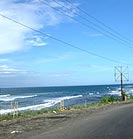 |
| Gilimanuk
Bay |
| Gilimanuk have a wide
range of coral beaches, white and black
sand beaches, and mangrove forest. The
beauty of the underwater coral attracts
people to dive in and do snorkeling.
There are two small islands in the bay:
Pulau Kalong (Bat Island) and Pulau
Burung (Bird Island). |
|
|
| |
|
 |
| |
| Candi
Dasa |
| Candi Dasa, south of Mount Agung
and slightly to the east, is a quaint seaside resort
from which to explore the secluded bays and ancient
temples. Travel on to Amed, Bali's desert beach,
complete with cacti, clear blue water and colourful
marine life. Amed is one of Bali 's most famous
dive sites. Besides being near many top dive spots,
Candidasa is near many cultural treasures - Pura
Besakih and Tenganan Village. For those looking
for a holiday off the beaten track a few days in
Candidasa would be a welcome respite. |
| |
| Mount Agung |
Mount Agung (3142m)
is the highest mountain in Bali and towering majestically
over eastern and northern Karangasem. On March,
17 1963, Mount Agung erupted which was the most
disastrous volcanic eruption. Streams of lava and
hot volcanic mud poured down to the sea in the southeast
of the island, covering roads and isolating the
eastern end of the island. The whole island was
covered in ash and crops were wiped out.
It destroyed many villages and temples, and killed
thousands of people. Most of those killed were either
burned to death or choked by the burning clouds
of hot gas rushing down the volcanic slopes. It
destroyed the whole villages of Sorga and Lebih.
Amazingly, Besakih village, just a few km from the
crater, suffered little damage. |
| |
| Padang
Bai |
| Padang Bai is the harbor for the
ferry service to Lombok. It is a quiet fishing village
located in a perfectly sheltered bay. The beach
is picturesque with its long sweep of sand where
multicolored boats are drawn up on the beach. |
| |
| Puri Agung
Karangasem |
| Puri Agung Karangasem, located in
Amlapura, the capital city of Karangasem, is an
impressive palace of ancient Karangasem kingdom.
It has a three-tiered gate and beautiful sculptured
panels on the outside. |
| |
| Tenganan
Village |
| Tenganan is a Bali Aga village,
one of the few Balinese communities to withstand
the Majapahit invasion in 1343. Protected for centuries
from the outside world by its surrounding walls,
Tenganan has preserved its ancient pre-Hindu customs.
This mountain village is famous for its tenun ikat
(double-weaving) called
‘geringsing’
which believed to have magical powers. It is also
well-known for its lontar sacred books, traditional
Balinese palm-leaf books. |
| |
| Tirta
Gangga |
| Tirta Gangga is located about 6km
from Amlapura. This water palace, built around 1947
by the King of Amlapura, is a place of beauty and
seclusion. The palace includes a complex of exotic
pools and a swimming pool surrounded by the beautiful
rice terraces. |
| |
|
 |
| |
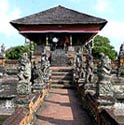 |
| Kertha
Gosa |
| Kertha Gosa (Court
Hall), surrounded by a moat,
is located in the center of Semarapura.
Built in 17th
century, it was once a part of Semarapura
Palace and used as a royal assembly
area for the kings of Bali. This building
is a perfect model of Klungkung architecture,
well-known for its painted ceiling in
Klungkung style. |
|
|
| |
| Kusamba |
| Kusamba is the coastal village outside
Klungkung. It is one of the embarkation points to
the islands of Nusa Penida, Nusa Lembongan, and
Nusa Ceningan. |
| |
| Nusa
Penida |
Nusa Penida once was an exile for
criminals and undesirables from Klungkung Kingdom.
Now, this secluded island is well-known as a great
place to surf and snorkeling.
The island also has some fascinating temples including
Ped Temple near Toyapakeh and Batukuning Temple
near Sewana. There is also a huge limestone cave,
Karangsari Cave, about 1km from Sewana. |
| |
| Taman Gili
(Bale Kambang) |
| Taman Gili, known as Bale Kambang
(Floating Pavilion),
is a beautiful palace which adjoins Kertha Gosa.
It is surrounded by lotus pond, representing an
isle of splendor surrounded by ocean. It is also
well-known for its exquisite painted ceilings telling
stories about the sacrifice of the hero 'Sutasoma',
and 'Pan and Man Brayut’ - the couple who
had too many children. |
| |
|
 |
| |
| Bedugul |
| Bedugul is a small lakeside village
over looking Lake Bratan. The weather is cold since
it is located in the highland. |
| |
| Blayu Village |
| Blayu is a small village located
on a parallel side road from Pacung to Bedugul.
This village is known for its traditional songket
sarongs. The songket sarongs for ceremonial use
are woven with gold thread. |
| |
| Jatiluwih
Village & Yeh Panes |
| Jatiluwih is a small village on
the slopes of Mount Batukaru. Jatiluwih means ‘truly
marvelous’ because the view is truly
encompassing a huge region of southern Bali. A hot
spring, Yeh Panes, is located on the road northwards
of Tabanan. |
| |
| Kebun
Raya Eka Karya Bedugul |
| Kebun Raya Eka Karya (Botanical
Garden) is located near Bedugul. It was established
in 1959 in 120 hectares of land as a branch of the
Bogor National Botanical Garden, which has a large
collection of native plants and over 500 specimens
of orchids. |
| |
| Lake Bratan |
| Motorboats and canoes are available
in Lake Bratan, as well as parasailing and water
skiing. Across the lake, there are some caves used
by the Japanese in World War II. From those caves,
there is a path to the top of Mount Catur, which
has an ancient temple at the top. |
| |
 |
| |
